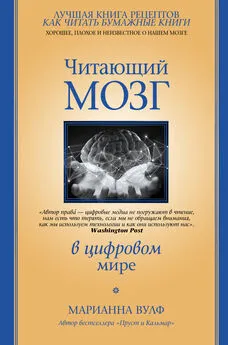Марианна Вулф - Пруст и кальмар. Нейробиология чтения
- Название:Пруст и кальмар. Нейробиология чтения
- Автор:
- Жанр:
- Издательство:ООО «Издательская Группа «Азбука-Аттикус»
- Год:2020
- Город:Москва
- ISBN:978-5-389-18966-9
- Рейтинг:
- Избранное:Добавить в избранное
-
Отзывы:
-
Ваша оценка:
Марианна Вулф - Пруст и кальмар. Нейробиология чтения краткое содержание
В этой книге, мгновенно завоевавшей мировую известность, видный американский нейробиолог Марианна Вулф исследует, как «открытая архитектура», пластичность нашего мозга помогает и мешает людям в их попытках научиться читать и обрабатывать письменный язык. Читателю предстоит увлекательное путешествие по временам и эпохам, знакомство с разнообразными иллюстрациями развития отдельного человека – от младенца, который слушает колыбельную, до настоящего эксперта – читателя произведений Пруста. Разобравшись, как эволюция и развитие чтения изменили само устройство человеческого мозга и суть нашей интеллектуальной жизни, мы поймем, что мы – это действительно то, что мы читаем.
В формате PDF A4 сохранён издательский дизайн.
Пруст и кальмар. Нейробиология чтения - читать онлайн бесплатно ознакомительный отрывок
Интервал:
Закладка:
59. O. Tzeng and W. S-Y. Wang (1982). Search for a Common Neurocognitive Mechanism for Language and Movements // American Journal of Physiology, 246. P. 904–911; O. Tzeng and W. S-Y. Wang (1983). The First Two R’s // American Scientist, 71. P. 238–243.
60. Pammer et al. Visual Word Recognition: The First Second Half.
61. D. Doehring, I. M. Hoshko , and M. Bryans (1979). Statistical Classification of Children with Reading Problems // Journal of Clinical Neuropsychology, 1. P. 5–16; R. Morris (1982). The Developmental Classification of Leaning Disabled Children Using Cluster Analysis // Dissertation, University of Florida.
62. M. Wolf and P. Bowers (2000). The Question of Naming-Speed Deficits in Developmental Reading Disability: An Introduction to the Double-Deficit Hypothesis // Journal of Learning Disabilities, 33. P. 322–324 (Special Issue); Wolf and Bowers . The ‘Double-Deficit Hypothesis’ for the Developmental Dyslexias; P. G. Bowers and M. Wolf (1993). Theoretical Links among Naming Speed, Precise Timing Mechanisms, and Orthographic Skill in Dyslexia // Reading and Writing, 5. P. 69–85.
63. M. W. Lovett, K. A. Steinbach , and J. C. Frijters (2000). Remediating the Core Deficits of Developmental Reading Disability: A Double-Deficit Perspective // Journal of Learning Disabilities, 33 (4). P. 334–358.
64. M. Wolf and P. G. Bowers (1999). The Double-Deficit Hypothesis for the Developmental Dyslexias // Journal of Educational Psychology, 91. P. 415–438.
65. См. работы по этим языкам: H. Wimmer, H. Mayringer , and K. Landerl (2000). The Double-Deficit Hypothesis and Difficulties in Learning to Read Regular Orthography // Journal of Educational Psychology, 92. P. 668–680; C. Escribano . The Double-Deficit Hypothesis: Comparing the Subtypes of Children in a Regular Orthography.
66. Когнитивный психолог и генетик Брюс Пеннингтон из Денверского университета ближе всего подошел к описанному здесь взгляду на овладение чтением и его нарушения с точки зрения хода развития и многообразия участвующих в нем процессов. В этом подходе «множественного когнитивного дефицита» могут быть обнаружены несколько возможных источников и проявлений нарушений чтения, и, в зависимости от времени и применяемой терапии, они могут видоизменяться. См.: B. F. Pennington (2006). From Single to Multiple Deficit Models of Developmental Disorders // Cognition, 101 (2). P. 385–413.
67. R. Morris, K. Stuebing, J. Fletcher, S. Shaywitz, G. R. Lyon, D. Shankweiler et al . (1998). Subtypes of Reading Disability: Variability around a Phonological Core // Journal of Educational Psychology, 90. P. 347–373.
68. Theresa Deeney, Calvin Gidney, Maryanne Wolf , and Robin Morris (1998). Phonological Skills of African-American Reading-Disabled Children. Представлено Обществу научных исследований чтения (Society for the Scientific Studies of Reading).
69. K. Landerl, H. Wimmer , and U. Frith (1997). The Impact of Orthographic Consistency on Dyslexia: A German-English Comparison // Cognition, 63 (3). P. 315–334.
70. K. Pugh, R. Sandak, S. Frost, D. Moore , and E. Mencl (2005). Examining Reading Development and Reading Disability in English Language Learners: Potential Contributions from Functional Neuroimaging // Learning Disabilities Research and Practice, 20. P. 24–30; L. H. Tan, J. Spinks, G. Eden, D. Perfetti , and W. Sick (2005). Reading Depends on Writing in Chinese // Proceedings of National Academy of Sciences, 102. P. 8781–8785.
71. C. Ho, D. W. Ghen, S. Lee, S. Taang , and Luan (2004). Cognitive Profiling and Preliminary Subtyping in Chinese Developmental Dyslexia // Cognition, 91. P. 43–75.
72. Escribano . The Double-Deficit Hypothesis.
73. T. Katzir, S. Shaul, Z. Breznitz , and M. Wolf (2004). Universal and Unique Characteristics of Dyslexia: A Cross-Linguistic Comparison of English– and Hebrew-Speaking Children (неопубликованные результаты исследований).
74. The Double-Deficit Hypothesis; Katzir et al. Universal and Unique characteristics of Dyslexi; Landerl et al. The Impact of Orthographic Consistency on dyslexia; Paulesu et al . Dyslexia: Cultural Diversity and Biological unity.
75. Albert Kleber , OSB, STD (1940). Ferdinand, Indiana, 1840–1940: A Bit of Cultural History. Saint Meinrad, Ind. P. 67.
1. D. Whyte (1990). The Faces at Braga // Where Many Rivers Meet. Langley, Wash.: Many Rivers.
2. P. G. Aaron and R. G. Clouse (1982). Freud’s Psychohistory of Leonardo da Vinci: A Matter of Being Right or Left // Journal of Interdisciplinary History, 13 (1). P. 1–16.
3. A. Einstein (1954). Letter to Sybille Bintoff. May 21. Цит. по: A. Folsing (1997). Albert Einstein. New York: Penguin.
4. S. F. Witelson, D. L. Kigar , and T. Harvey (1999). The Exceptional Brain of Albert Einstein // Lancet, 353. P. 2149–2153.
5. Ibid.
6. Особое мнение можно найти в статье: A. Galaburda (1999). Albert Einstein’s Brain // Lancet, 354. P. 1821.
7. Witelson et al. The Exceptional Brain of Albert Einstein.
8. A. M. Galaburda (2005). November 27. Личная переписка.
9. S. Orton (1928). Specific Reading Disability – Strephosymbolia // Journal of the American Medical Association, 90. P. 1095–1099.
10. N. Geschwind (1982). Why Orton Was Right // Annals of Dyslexia, 32. P. 13–28.
11. Ibid. P. 21–22.
12. A. Galaburda (1993). Neuroanatomical Basis of Developmental Dyslexia // Neurological Clinical, 11. P. 161–173; A. Galaburda, J. Cosiglia, G. Rosen , and G. Sherman (1987). Planum Temporale Asymmetry: Reappraisal since Geschwind and Levitsky // Neuropsychologia, 25. P. 853–868.
13. Джордж Хайнд, Линн Флауэрс и их команда повторили исследование, подтвердив увеличение правополушарной PT у группы людей с дислексией, но исследователям из Стэнфорда, Джону Габриэли и его команде, это не удалось. Последние допустили, что эта правополушарная особенность может присутствовать только в какой-то подгруппе людей с дислексией и это лейтмотив большого количества исследований этого состояния. Паулин Филипек сделала обзор ряда исследований асимметрии и пришла к выводу, что подтверждающих доказательств слишком мало, отчасти из-за несоответствия отображений в разных исследованиях (то есть различий в том, где начинается одна область и кончается другая). К такому же выводу пришла и группа из Стэнфорда. См.: P. A. Filipek (1995). Neurobiologic Correlates of Developmental Dyslexia: How do Dyslexics’ Brains Differ from Those of Normal Readers? // Journal of Child Neurology, 10 (1). P. 62–69; Galaburda . Neuroanatomical Basis of Developmental Dyslexia; G. W. Hynd, M. Semrud-Clikeman, A. R. Lerys, E. S. Novey , and D. Eliopulos (1990). Brain Morphology in Developmental Dyslexia and Attention Deficit Disorder/Hyperactivity // Archives of Neurology, 47. P. 919–926.
14. A. Galaburda (2006). Dyslexia: Advances in Cross-Level Research // The Dyslexic Brain. G. Rosen (ed.). Mahwah, N.J.: Erlbaum; A. R. Jenner, G. D. Rosen , and A. M. Galaburda (1999). Neuronal Asymmetries in Primary Visual Cortex of Dyslexic and Nondyslexic Brains // Annals of Neurology, 46. P. 189–196.
15. Jenner et al. Neuronal Asymmetries in Primary Visual Cortex of Dyslexic and Nondyslexic Brains. См. также: J. C. Greatrex and N. Drasdo (1995). The Magnocellular Deficit Hypothesis in Dyslexia: A Review of Reported Evidence // Opthalmic and Physiological Optics, 15 (5). P. 501–506.
16. G. Rosen (ed.) (2005). The Dyslexic Brain: New Pathways in Neuroscience Discovery. Mahwah, N.J.: Lawrence Erlbaum; G. D. Rosen et al. (2001). Animal Models of Developmental Dyslexia: Is There a Link between Neocortical Malformations and Defects in Fast Auditory Processing? // Dyslexia, Fluency, and the Brain. M. Wolf (ed.). Timonium, Md.: York. P. 129–157.
17. B. Chang, T. Katzir, C. Walsh et al. (2007). A Structural Basis for Reading Fluency: Cortico-Cortical Fiber Tract Disruptions Are Associated with Reading Impairment in a Neuronal Migration Disorder.
18. M. Wolf and T. Katzir-Cohen (2001). Reading Fluency and Its Intervention // Scientific Studies of Reading, 5. P. 211–238. (Special Issue.)
19. S. Petrill (2005). Introduction to This Special Issue: Genes, Environment, and the Development of Reading Skills // Scientific Studies of Reading, 9. P. 189–196.
20. E. Grigorenko (2005). A Conservative Meta-Analysis of Linkage and Linkage-Association Studies of Developmental Dyslexia // Scientific Studies of Reading, 9 (3). P. 285–316.
21. B. F. Pennington (2006). From Single to Multiple Deficit Models of Developmental Disorders // Cognition, 101 (2). P. 385–413.
22. K. Hannula-Jouppi, N. Kaminen-Ahola, M. Taipale, P. Eklund, J. Nopola-Hommi, H. Kaariainen , and J. Kere (2005). The Axon Guidance Receptor Gene ROBO1 Is a Candidate Gene for Developmental Dyslexia // PLOS Genetics, 1 (4). P. 467–474.
23. H. Meng, S. D. Smith, K. Hager, M. Held, L. Liu, R. K. Olson, B. F. Pennington, J. C. DeFries, Gelernter, T. O’Reilly-Pol, S. Semlo, Skudlarski, S. E. Shaywitz, B. A. Shaywitz, K. Marchiene, Y. Wang, M. Paramasivam, J. J. LeTuree, G. P. Page , and Gruen (2005). DCDC 2 Is Associated with Reading Disability and Modulates Neuronal Development in the Brain // Proceedings of National Academy of Sciences, 102 (47). P. 17053–17058.
24. K. Hannula-Jouppi, N. Kaminon-Ahola, M. Taipale, R. Eklund, J. Nopola-Hemmi, H. Kaariainen , and J. Kere (2005). The Axon Guidance Receptor Gene ROBO1 Is a Candidate Gene for Developmental Dyslexia; J. Nopola-Hemmi, B. Myllyluema, A. Voutilainen, S. Leinonen , and J. Kere (2002). Familial Dyslexia: Neurocognitive and Genetic Correlation in a Large Finnish Family // Developmental and Medical Child Neurology, 44. P. 580–586.
25. R. K. Olson (2004). SSSR, Environment, and Genes // Scientific Studies of Reading, 8 (2). P. 111–124; B. Byrne, C. Delaland, R. Fielding-Barnsley, P. Quain, S. Sumelsson , and T. Hoien (2002). Longitudinal Twin Study of Early Reading Developmental in Three Countries: Preliminary Results // Annals of Dyslexia, 52. P. 49–74.
Читать дальшеИнтервал:
Закладка:










